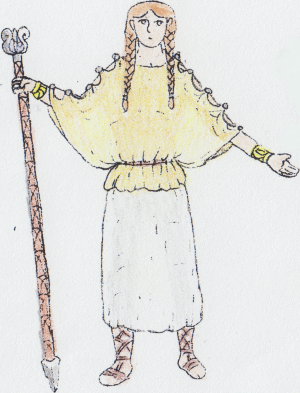Azókani
The azókani are natives of the Azókan Islands in the southwestern Central Sea.
Zameltoníans frequently sent expeditions to the islands in search of yellow marble and purple dye. Only the people of the island of Eikan were on good terms with them, while many of the tribes on Skeziran resisted the zameltoníans as much as they could. When bronze-working spread from Góalanis, one of the skeziranic chiefs, Lömertnes, managed to unite the tribes against the zameltoníans and then conquered the rest of the isles. After the fall of Zameltonía, the azókani became notorious pirates, striking fear into practically every coastal settlement in Nemirkía and Góalanis until they were defeated by the Paþarían Empire. The paþaríans established colonies on the islands, but their influence was mostly limited to the cities they founded.
The azókani faced orcish invasions around and after the fall of Paþaría, which eventually resulted in the orcish Bólrans and Hargúls being pushed back to the island of Úrra, where they still live to this day. On the mainland, azókani slingers became highly sought after as mercenaries and later as auxiliaries in the sikíronian army after the islands were conquered by the Sikíron Empire.
History
The ancestors of the azókani were humans from Nemirkía who settled on the islands in waves, founding small communities which eventually evolved into chiefdoms. Contact with the mainland was limited during the little ice age around 16-12.000 b. Paþ, which preserved a great deal of traditions that mostly disappeared in Nemirkía due to influences from tribes migrating there from the north.Zameltoníans frequently sent expeditions to the islands in search of yellow marble and purple dye. Only the people of the island of Eikan were on good terms with them, while many of the tribes on Skeziran resisted the zameltoníans as much as they could. When bronze-working spread from Góalanis, one of the skeziranic chiefs, Lömertnes, managed to unite the tribes against the zameltoníans and then conquered the rest of the isles. After the fall of Zameltonía, the azókani became notorious pirates, striking fear into practically every coastal settlement in Nemirkía and Góalanis until they were defeated by the Paþarían Empire. The paþaríans established colonies on the islands, but their influence was mostly limited to the cities they founded.
The azókani faced orcish invasions around and after the fall of Paþaría, which eventually resulted in the orcish Bólrans and Hargúls being pushed back to the island of Úrra, where they still live to this day. On the mainland, azókani slingers became highly sought after as mercenaries and later as auxiliaries in the sikíronian army after the islands were conquered by the Sikíron Empire.




Comments